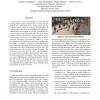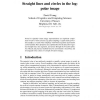5305 search results - page 2 / 1061 » Modeling Foveal Vision |
ICRA
2006
IEEE
14 years 2 months ago
2006
IEEE
— In this paper we discuss active humanoid vision systems that realize foveation using two rigidly connected cameras in each eye. We present an exhaustive analysis of the relatio...
AVSS
2006
IEEE
14 years 2 months ago
2006
IEEE
In this paper we report on techniques for automatically learning foveal sensing strategies for an active pan-tiltzoom camera. The approach uses reinforcement learning to discover ...
ICPR
2002
IEEE
14 years 1 months ago
2002
IEEE
A motion estimation algorithm for log-polar images, based on a previous general framework [2], is presented. The advantages and disadvantages brought by the use of this kind of fo...
BMVC
2000
13 years 9 months ago
2000
Foveal or spatially-variant image representations are important components of active vision systems. Log-polar sampling is a particularly powerful example as a result of the simpl...
BC
2006
13 years 8 months ago
2006
Abstract In primates, it is well known that there is a consistent relationship between the duration, peak velocity and amplitude of saccadic eye movements, known as the `main seque...


